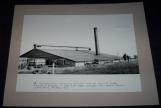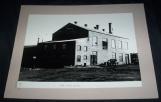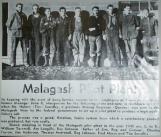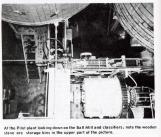28
EVAPORATED SALTAn evaporation plant was built in 1928. It used brine that was collected in a cavity in the MacKay seam, Brine Pond No. 4 level, and also brine was created on the surface by spraying the waste salt pile.
A high quality coarse salt for the fishery trade was made until 1947 when the process was discontinued.
30
This photo shows a salt clay treated section of highway at Elmsdale, NS on August 16th, 1932. It is believed that highway stabilization was first carried out by the Malagash Salt Company.George W. MacKay said to John MacQuarrie in March, 1972, "We never made any money until we got into the highway salt business."
32
An extract form an interview with Kenny Wilson that mentions why the Malagash Salt Company began shipping salt for use on the highways in Ontario.So where else did they ship to? You said they shipped to Newfoundland with the fish salt; did they ship to Ontario or other parts of Canada?
They started to ship to Ontario because one of our salesmen encouraged the Ontario government to start to use salt on the highway, to take ice off the highway; and it was quite was successful.
Do you remember his name?
Don't remember his name, no. Actually we have his picture downstairs.
So when did they start doing that, do you remember; was that middle fifties?
Yes, that would be about 1953, or something like that.
So did other areas start doing that besides Ontario?
Yes. Once they found out it worked. The one difference about Malagash salt even today, some of the seams of salt we had here in Malagash had a little bit of potash in it; and just a little bit of potash and salt would actually melt ice at ice at a lower temperature. That would be on the old Fahrenheit scale that would melt ice at 5 below zero, and of course the salt they use today doesn't do that?.. But salt and potash with a little bit of water when you mix you see start boiling, the reaction of the two chemicals.
34
This photo shows the burnt power house that had also housed the Busch Selzer diesel engine, the second diesel built in America.36
The new Power House was built in 1942.38
This photo from 1945 shows a group of workers standing outside the Malagash Pilot Plant, that was set up by the Federal government to produce a high purity fishery salt.40
PILOT PLANT BUILT IN MALAGASH IN 1945A pilot plant was built under the direction of Smedley and Turrell, with the co-operation of Federal and Provincial governments and Nova Scotia Technical College and Canadian Industries, at Malagash. It produced a high quality fused salt in small (10 tons per 24 hour day) commercial quantities in 1945, the first such production in North America.
The pilot plant continued until mid 1947. It made a beautiful product from variable purity rock salt but the fuel for fusing made the process expensive.
The rock salt was ground to minus 65 mesh and then put through floatation cells. The salt was depressed and the impurities floated. Then the salt was dried on a filter from which it went to a reververatory furnace where it melted at 801 C degress, or 1473 F but the furnace was run at 1525 F.
The molten salt ran into a conveyor of laddles where it cooled into blocks, before crushing to sizes for the fishery trade.
In 1947 The Diamond Crystal Salt Co. sent a car of table salt (bagged) which was fused at Malagash and the product returned to Michigan. The process was discontinued in autumn 1947.






